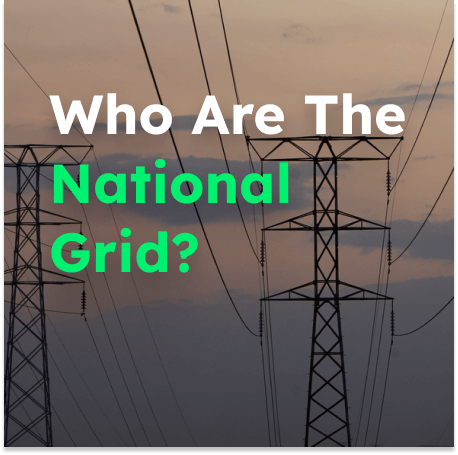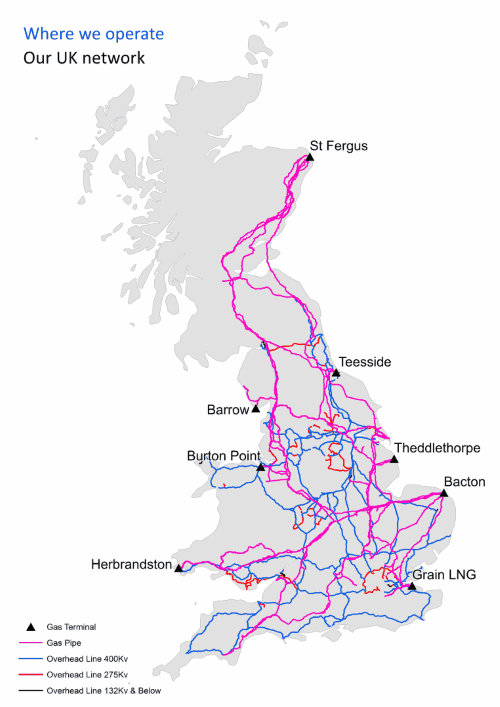What Is The National Grid UK?
The National Grid owns and operates the electricity transmission network covering England and Wales. The transmission network in Scotland is owned by two companies, Scottish Power and SSEN, but the National Grid operates it. They also own and operate the gas National Transmission System in Great Britain.

What Does The National Grid Do?
The National Grid’s role in the electricity and gas transmission network is to manage the flow of energy and balance the supply and demand of both gas and electricity to homes and businesses in Britain. In addition, they are responsible for the quality of the electricity and the security of the supply.
They manage gas and electricity supply and demand on a real-time basis ensuring that there is sufficient energy to meet demand. They are also responsible for accounting for any energy losses in the network and reducing these losses.
They are not responsible for:
- Supplying or generating gas or electricity
- Pipes and cables that deliver gas or electricity to homes and businesses (unless they are large-scale industrial operations), this is the role of the distribution network operators (DNOs)
- Connecting homes and businesses to the gas and electricity network (unless they are large-scale industrial operations or large power stations), is the role of the distribution network operators
- Supplying gas or electricity to homes or businesses and billing customers is the role of the energy supply companies
National Grid Contact Number
Landowners – 0800 389 5113 (electricity) or 0800 688 588 (gas)
Power cuts – 105, lines are open 24 hours a day, seven days a week and are free of charge
Gas leaks – 0800 111 999, lines are open 24 hours a day, seven days a week and are free-of-charge
National Grid Address
National Grid
1-3 Strand
London
WC2N 5EH
Website: https://www.nationalgrid.com
National Grid Gas & Electricity Network Route Map

How Does The National Grid Differ From The Rest Of The Energy Network?
The National Grid operates the electricity distribution network that transports electricity from the generators to the local distribution networks. The electricity is transported at a higher voltage than what it can be used at so that it makes it easier to transport and it suffers from fewer losses. The local distribution network operators are responsible for converting the electricity to a lower voltage and delivering it to the end user. They operate and maintain their electricity networks.
The National Grid also operates the gas distribution network and like the electricity transmission network, they only transport gas from the shippers to the local distribution networks. They do not manage or own the local networks.
The supply of gas and electricity and billing customers is the responsibility of the energy supply companies who pass on the charges for utilising the National Grid and local distribution networks to the energy customers.
National Grid’s Network and Assets
Electricity network and assets:
- 7,200 km /4,474 miles of overhead cables
- 1,500 km / 932 miles of underground cables
- 342 substations
Gas network and assets:
- 7,000 km / 4,400 miles of high-pressure pipes
- Over 600 above-ground installations
How Is The National Grid Regulated?
The National Grid operates under strict regulation both from the UK government and Europe as well as needing to comply with various standards and licence requirements.
Ofgem is the UK energy industry regulator and they place various restrictions and requirements on the National Grid which include price controls and standards. They license the National Grid’s operations under the Gas Act 1989 and Electricity Act 1989, which requires them to maintain and operate efficient and cost-effective networks for gas and electricity.
There are numerous documents that they must produce each year to prove compliance with the electricity and gas industry standards and licence requirements. As well as reaching performance incentives for their gas and electricity system operations.
Ofgem has also introduced a regulatory framework aimed at incentivising network companies to innovate and secure investment to deliver more sustainable energy networks at the lowest cost. This framework is called RIIO which stands for Revenue = Incentives + Innovation + Outputs. The delivery of RIIO is integrally linked to the revenue that the National Grid can generate.
In addition, there are numerous regulations and codes that the National Grid must meet under EU requirements. Many EU network codes need implementing over the next decade which will be challenging for the National Grid.
How Does The National Grid Manage Capacity?
National Grid Electricity
It is the National Grid’s responsibility to produce energy services to meet the energy demand and supply in the British transmission system to ensure the security and quality of the energy supply.
The Electricity Market Reform allows the National Grid to manage the electricity capacity in the transmission network through the Capacity Market which is open to all electricity generators, electricity storage plants, voluntary demand reduction, and interconnectors. This gives predictability in the energy market to encourage future investment as it gives them capacity payments to deliver energy at times of greater need or when they face penalties.
Providers can secure capacity payments by participating in competitive auctions which sets the level of these payments. These auctions are held four years in advance of the delivery with a further auction one year ahead. 2018 will be the first year of delivery under the Capacity Market framework. When a high-stress occurrence is expected and energy demand is higher than supply they will issue a notice four hours ahead of the need.
National Grid Gas
The National Grid manages the capacity, demand, and supply of gas through complex arrangements including:
- A demand-side response where larger gas users are encouraged to reduce their gas consumption by offering the daily metered supplied customers the opportunity to reduce their demand at times of system stress
- Margin Notices and Gas Deficit Warnings aim to warn users with a day-ahead notice of a pending shortage, although the Gas Deficit Warnings can be made on the day. Users are expected to respond if needed by releasing further capacity
- On-the-Day Commodity Market trades gas either a day ahead or on the day with participants competing anonymously
- Operating margin is capacity that is purchased annually and stored for periods of high stress on the system or when there are failures in the supply
How Is The National Grid Funded?
Electricity
The National Grid is funded through charges to the companies that use its network to transport electricity from the generator to the end user.
- Electricity generators are charged a tariff based on their operation
- Suppliers are based on their demand forecasts
- Tariffs are based on the geographical zone that the users are connected to
Ultimately the energy users pay for the costs of the National Grid via their energy bills. These pass-through charges from the National Grid typically account for less than 5% of the average electricity bill.
Charges are split up into two categories:
- Transmission network use of system charge which recovers the cost of maintenance and upgrading of the transmission system
- Balancing services use of system charge which recovers the day-to-day cost of the National Grid’s operations which is a flat rate for all users
The National Grid also recovers its costs from the installation and maintenance of connecting assets to the transmission network. These charges are calculated each year and charged each month.
How Is National Grid Gas Charged?
Gas is charged in the following amounts:
- Commodity in p/kWh
- Exit capacity in p/kWh per day
- Entry capacity in p/kWh per day
- Fixed pence per day
The National Grid’s revenue for gas transportation charges is restricted by Ofgem and there is a price formula to calculate this. If the amount is less or more than this amount in a year, then the following year will be adjusted to reflect this.
This price control affects the Transportation Owner and System Operator charges. The Transportation Owner charges are split between exit and entry volumes. Entry charges are determined by auctions. System Operator charges are recovered from the Commodity charge which is a fixed charge.
Gas shippers and distribution network operators pay these charges and the costs are passed on to the gas customer through their bills.
National Grid Complaints
As the National Grid only serves the gas and electricity industry there is no complaints process for domestic or business energy users. If you have a complaint regarding the gas or electricity network supplying your home or business, you should contact your local distribution network operator. If you have a complaint regarding your gas or electricity bills, you should contact your energy supplier.
There is a team that deals with issues relating to any National Grid assets that are on privately owned land. If you are a landowner, you can contact them by email.
The Future Of The National Grid
In 2019, there will be a significant shift in the National Grid business as they are separating their electricity system operator from their electricity transmission owner, and these two functions will operate as two separate entities. The reason behind this is to assist the business in operating each function independently, keeping energy bills down, and aiding the growth of a more flexible grid.
There are significant challenges facing the UK energy industry including ageing infrastructure, decarbonisation, the requirement to create a smart grid, and energy storage. Investment is desperately needed to allow the energy industry to adapt and create a network that meets future needs and to create a smart grid. There is much resistance to increasing energy prices to pay for this investment and therefore the government needs to intervene and assist the industry.
The National Grid is working with the government and the rest of the energy industry to assist in reducing carbon emissions for energy and decarbonising gas and electricity. This makes National Grid’s role more challenging as the drive is to move towards more renewable energy and potentially nuclear energy.
Renewable energy has many challenges as the supply of electricity is not constant or predictable but is more flexible as it can be switched off almost instantly when the demand is low. The advancements in energy storage technology are increasing in pace due to there being a race to create effective energy storage solutions and it is attracting a lot of investment.
Effective energy storage will make renewable energy more feasible on a larger scale and enable the proportion of renewable energy in the UK electricity mix to increase substantially. Renewable energy is also more localised which meets the drive towards more localised energy production to reduce the demand for transporting significant amounts of electricity from key areas of the country.
Nuclear energy provides a stable energy supply, but it is very inflexible as it requires significant notice to reduce its output. It also is not the cheapest or greenest solution to produce electricity and does not fit in with the drive for localised electricity production.
Gas plays a part in the electricity fuel mix in gas-fired power stations as well as for heating and cooking. Gas has a role in the decarbonisation of energy in reducing the need for coal-fired power stations as gas can replace them and provide the stability of electricity and a backup for renewable energy’s intermittent supply. There are also the impacts of introducing biomethane and other gases into the mix that need further consideration and investment.
You may also like: DUoS & TNUoS Charges